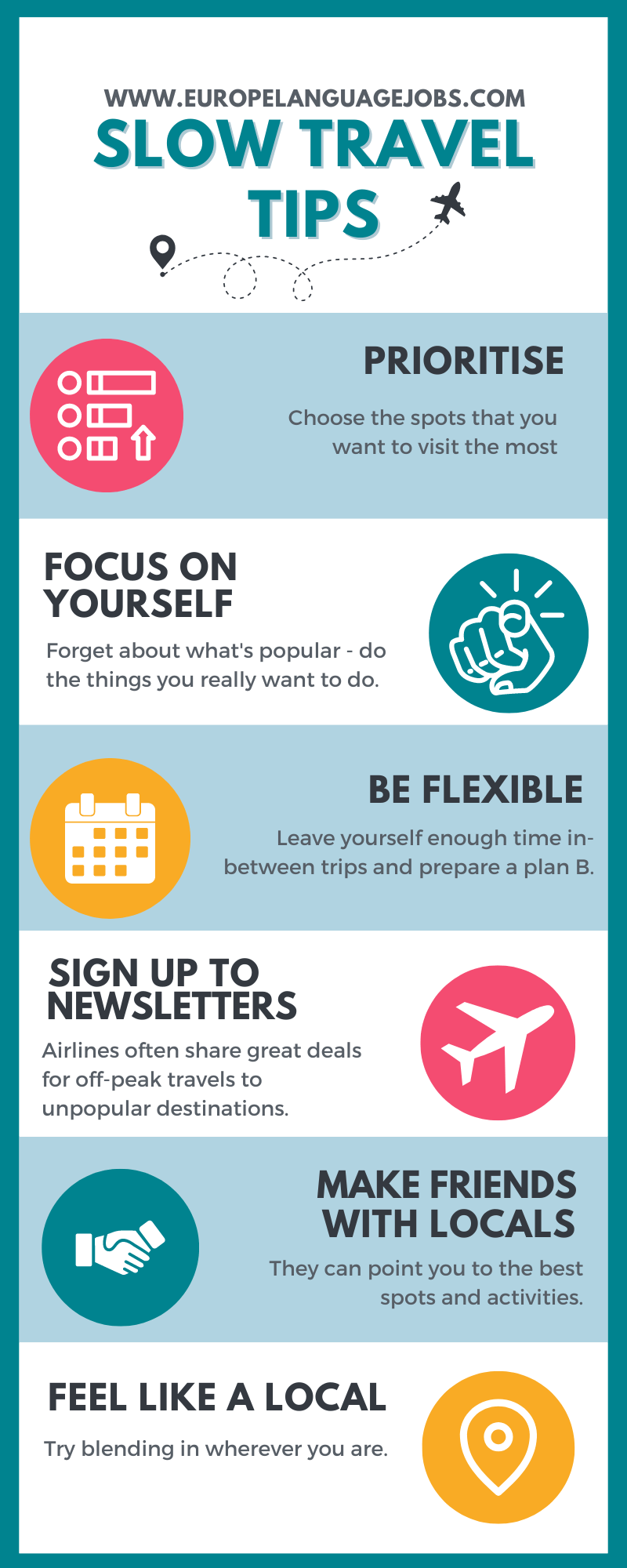Holidays are oftentimes a paradox. On the one hand, we want to rest and reset. On the other, we are driven by this urge to see as much as possible, to use the time spent in a new place to the max. This FOMO (Fear Of Missing Out) drives us out of our minds, fills our systems with adrenaline and causes us to move faster than humanly possible.
It’s understandable, of course. Travelling comes with costs. It’s obvious that if we’ve paid a big sum for the flight, we want the investment to pay back once we get there and wish to see all the best spots. But have you ever come back from your trip feeling as though, despite having seen and done everything, in truth, you’ve achieved nothing?
If so, the answer to your problems might be slow travel.
What is slow travel and how can I embrace it?
Slow travel is all about trying to truly understand the place you’re visiting. It’s about slowing down, enjoying the moment, and adopting the carpe diem lifestyle.
The point is not to focus on the next steps of your journey but on the ones you’re taking at this moment. The aim is to stay in the here and now, and to leave yourself enough time to reflect on what you’ve experienced so far. It’s about putting the emphasis on what you did, rather than on what you didn’t do.
Benefits of slow travel
Before we move on to slow travel tips, let’s break down a few main benefits of travelling slow. These are just a few reasons why slow travel is the best:
You avoid the stress of a packed itinerary
By choosing to visit fewer spots, you get more time in-between visits to move around stress-free.
You can let yourself enjoy the moment without worrying about having to rush to your next destination
Without having to be somewhere within the next hour, you can linger a bit longer in a place you like or explore the neighbourhood.
You get a deeper understanding of the local customs and culture
By choosing to avoid the tourist frenzy, you will dedicate more time to attending activities that are popular in the area or discovering shops and restaurants run by locals.
You can fully appreciate your free time and the place you’re in
When you don’t have to keep glancing at your watch, you can take in the beauty of what’s around you.
Often, you will discover less popular spots that deserve recognition
When you steer off the traditional tourist path, you are bound to stumble upon places you never knew you never knew about.
It might turn out more affordable
The most popular tourist attractions are usually the most expensive ones - by choosing to limit them or avoid them altogether, you will help out your travel budget, or will be able to spend that money on something you deem more important.
It’s more sustainable
More about that in the following paragraph…
Is slow travel sustainable?
There are several reasons why slow travel is more sustainable. First of all, if you decide to slow down and visit fewer places, chances are you won’t move around so much. That will lower the CO2 emissions as you limit commute by bus, train, taxi, car, or any other means of transport you would usually use to get around. With more time to spare, you can also choose the slower but most eco-friendly ways of moving around: walking or cycling.
Secondly, by travelling slow, you will have more opportunities to properly support the local community. You may choose to stay in private accommodation run by the locals rather than in big international hotels that are usually located closer to tourist hotspots.
The same applies to eating out and shopping - in a rush, you would probably only visit chain markets you recognise to find the necessary items quicker. That way, you risk limiting yourself to consuming products you know from home, rather than taking the time to stroll along the isles and search the shelves for local delicacies. That’s also the case with restaurants.
When looking for souvenirs, slow travel allows you to wander off to cute hidden spots, tucked away from the hustle and bustle of the stalls in the centre. Venturing off the beaten path will allow you to discover items that have been truly hand-made by the locals, rather than shipped there from far away.
Slow travel tips
Now that we all know what slow travel is and how both we and the environment can benefit from it, let’s go over some ideas on how to embrace the slow travel experience:

1. Prioritise
The holiday rush is often the result of poor planning. If you fail to define your top destinations, you will end up trying to visit all of them, and then some. Don’t bite off more than you can chew - measure your plans up against the time you have available. Avoid cramming what should be a week-long trip into your 3-day itinerary. You’ll wear yourself out!
Before departing, do your research. Look for the best spots to visit in your planned destination, and decide which ones speak to you the most. Would you rather focus on nature - visit natural parks and botanical gardens? Or do you prefer the urban lifestyle, and what calls out to you is the architecture, museums, and nightlife?
Be honest with yourself and lead off by asking what it is that you truly want to gain from this trip. Once you know the answer, it will be easier to pick the spots you’ll want to prioritise.
Pro tip: a simple pros and cons table can be a lifesaver in this case. Compare the advantages and disadvantages of each place, taking into consideration aspects like the entry fee, distance from accommodation, reviews, and your own personal motivations for visiting.
2. Focus on yourself - forget about others
Did you know that 37% of people who document their travel on social media are motivated by simply wanting to make their followers jealous by posting photos and videos from their sustainable trip? That's nearly 4 out of 10 travellers being driven by vainness rather than an honest will to have a memorable experience.
What sometimes stands in the way of correctly identifying what we really want to experience is other people. We simply can’t stand the thought of visiting Paris and not taking a picture by the Eiffel Tower. Does it even count if, at the end of your trip, you don’t grace your feed with a photo of you and the famous landmark? It’s like you weren’t even there!
Wrong.
Forget about the gram. The value of your trip is not reflected by the number of likes under the reel you’ve made documenting it. The desire to choose what is popular over what we really want is strong - sometimes, the lines are so thin they blur. We’ve all been there.
Don’t turn your itinerary into a checklist of spots you’ve seen marked as “must-see” on Pinterest. Yes, it will be nice to see Big Ben, Buckingham Palace, Hyde Park, Tower Bridge, St. Paul’s Cathedral, Trafalgar Square, London Eye, Tower of London, the British Museum, and Westminster Abbey while visiting the British capital. It would be cool to post them all in your stories.
But it will also be great to pick your top 3, and then spend the afternoon enjoying a nice cuppa tea with a Victoria sponge cake in a cosy little cafe free of tourists. The coast is just a 2-hour train ride away from London. Instead of getting trampled by guided tours, you could be spending the day at the beach if that’s your jam.
Holidays are your time. If you’re travelling with others, discuss your plans and goals together. But remember that the only people who should influence where you go and what you do on your trip - are the people participating in the trip.
3. Leave a margin of flexibility throughout your travel
Ever came back from your holidays more stressed than when you’d left for it? Was it because your itinerary was so packed, you’ve had trouble finding a moment to grab a bite or go to the loo?
Accidents happen. A bus can be late. A spot you really wanted to visit can end up being temporarily closed for renovation. A traffic jam on the way can make you miss your time slot. Bad things happen to good people, so it’s better to be prepared for surprises.
If you choose to visit fewer spots, you’ll have the comfort of being able to take your time in-between planned visits. You’ll be able to linger in a nice park you hadn’t expected to discover on your way a moment longer. You’ll have the possibility to jump on an earlier bus to make sure you get to your destination with time to spare. In other words, you’ll avoid all the stress resulting from busy itineraries and back-to-back schedules.
Prepare a little backup in case any of your primary destinations turn out unavailable. Plan out your trips in an efficient manner - group places that are close to one another together instead of running back and forth like a madman. Don’t book your visits one after another - leave enough time in between them to avoid leaving early or rushing.
4. Be flexible with travel dates and destinations
Who isn’t signed up for the newsletter of at least one major airline? For most of us, however, the majority of emails probably end up in the “Promotions” folder, never to be opened.
Such newsletters, or various apps such as Skyscanner, are a slow traveller’s best friend. Great deals are usually offered off-season or for less popular destinations. If you’re not fussy about where and when you go, you can both save money and promote the slow travel lifestyle.
5. Make friends with the locals
Nobody knows how to avoid tourists as well as the locals do. If you’re not keen on popular spots, or simply want more from your trip, ask someone who calls your destination home for recommendations.
There are so many ways to interact with locals: Meetup, Facebook groups, Couchsurfing, striking up a conversation with an employee at a shop or restaurant, or even talking to someone at your accommodation, if possible. Maybe you have friends in different corners of the world who will be happy to host you, or just show you around?
Someone who knows the place well will be able to provide better advice than any online guide or website. They will be better informed about any recent changes such as temporary or permanent closing than pages that might not have been updated for a while - as well as recent openings of places that deserve your attention.
Of course, we must remember that locals aren’t tourists. Their perspective living in the place will be different from that of someone visiting it on holiday. They may not be aware of the current ticket prices or museum opening times, but that sort of information can easily be found online - especially since official websites are updated regularly.
The unique kind of advice you can expect, however, is about where to eat well and for a good price, where to party, what to see, how to find the best deals and, most importantly, where not to go. No one living in a particular place attends paid activities on a daily basis. Because of that, a local friend will point you to the best free attractions available in the area.
6. Try to feel like a local
The phenomenon of slow travel is all about experiencing your destination at its roots. By travelling slow, you take steps to deeply understand the place on many levels, to develop a connection to it.
If you’re anything like us, you won’t feel satisfied by simply checking top spots off your list, snapping a few pictures, and getting a postcard to remember it all. You’ll feel the need to do more.
The best way to do it, from our experience, is to try to merge into the crowd. This is a great method that can be done in many different ways, depending on individual preferences. There are tons of things you can do to feel like a local!
-
Learn a bit of the local language and try to carry out basic interactions (in a shop, restaurant, etc.) in it
-
Do your shopping in places frequented by the locals (they know where all the good deals are)
-
Participate in activities that are popular in your destination (for example, if everybody there surfs, sign up for a class or attend a game somewhere where everyone is crazy about rugby!)
-
Attend a national holiday - you can plan your trip around the time of a local event to experience it first-hand
-
Try the local cuisine - preferably in bars and restaurants that are a bit less tourist-oriented and usually host the locals
Pro tip: If you’re dreaming about experiencing a real homemade meal in a familiar atmosphere, Eatwith gives you the possibility to attend all kinds of food-related events: from cooking classes to cosy family dinners to big dinner parties! You will find both humble locals sharing their family recipes and MasterChefs serving you top-notch dishes there.
Is slow travel worth it?
We’d really like to get to know your opinion here! Obviously, there are different levels to slow travel - it doesn’t necessarily have to be all or nothing.
You don’t have to swear off all the tourist spots whenever you go for the rest of your life. You don’t have to bend over backwards to eat only in locally owned restaurants or pester people in the streets trying to force them to be your local friend.
You can start off slow (pun fully intended). For your every trip, sit down and ask yourself what it really is that you want. Maybe you’re craving a busy schedule and want to feel the adrenaline of seeing as many spots as possible - there’s nothing wrong with that. But don’t feel obliged to do so if what you’d rather do is spend a day reading a book in the local park.
We’ve done our part to show you why in our opinion, slow travel is the best. However, remember that the whole idea behind it is to relax, slow down, and put the focus on what you want. You shouldn’t pressure yourself into travelling extremely slow. If you want to see the Eiffel Tower, see it. What’s important is for you to know that there are many ways to travel, and the one followed by most doesn’t have to be the obvious choice if you’re not comfortable with it.
Feeling inspired? Visit our blog for more career advice! How can you be sure the information we provide is top-notch? We are a group of professionals working with recruiters, career coaches, and HR specialists from all over the world!
Trust our experience and let us help you find a new job in Europe!


















Lucyna Polok11mo ago
Hi, Naiara! Thank you so much for this insightful comment. Yes, I know exactly what you mean - I have experienced it so many times. I'm an art enthusiast and art museums usually top my list of places to visit whenever I go somewhere new. I have also experienced both types of travel and it's so incredibly stressful to try to appreciate an art museum during a week-long trip! It's very true that the money spent and the pressure of time make the experience way less enjoyable than it should be. Many cities offer free entry into various cultural facilities on the weekends (all of them or just the first weekend of the month), so that's a great opportunity for someone who can stay for longer! That way, we can stretch the visits out in time over weeks or even months, and not feel as overwhelmed. Of course, this is not always possible - I also prefer slow travel, but still do sometimes go on trips that only last a few short days. Work and other duties won't always allow us to travel wherever we want, for however long we wish. What matters is that such possibilities exist, and that we keep the idea of slow travel in mind whenever we can. Thanks so much for this!
Hi, Naiara! Thank you so much for this insightful comment. Yes, I know exactly what you mean - I have experienced it so many times. I'm an art enthusiast and art museums usually top my list of places to visit whenever I go somewhere new. I have also experienced both types of travel and it's so incredibly stressful to try to appreciate an art museum during a week-long trip! It's very true that the money spent and the pressure of time make the experience way less enjoyable than it should be. Many cities offer free entry into various cultural facilities on the weekends (all of them or just the first weekend of the month), so that's a great opportunity for someone who can stay for longer! That way, we can stretch the visits out in time over weeks or even months, and not feel as overwhelmed. Of course, this is not always possible - I also prefer slow travel, but still do sometimes go on trips that only last a few short days. Work and other duties won't always allow us to travel wherever we want, for however long we wish. What matters is that such possibilities exist, and that we keep the idea of slow travel in mind whenever we can. Thanks so much for this!